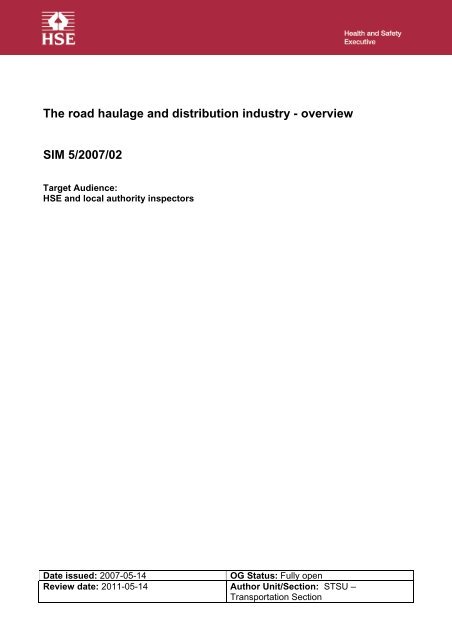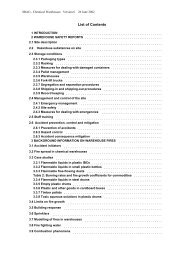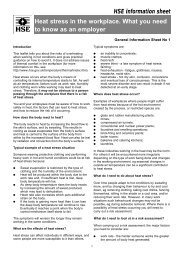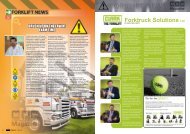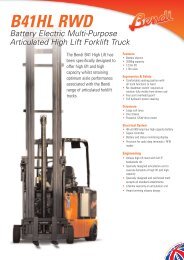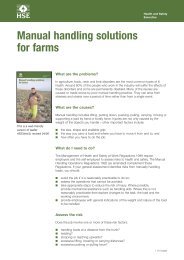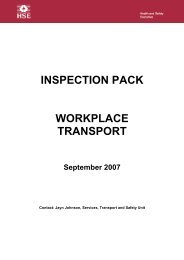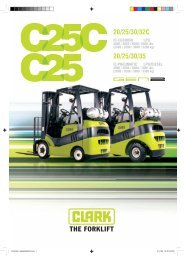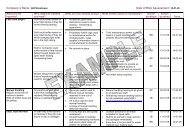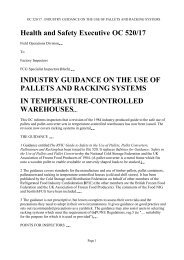The road haulage and distribution industry - overview - Forktruck ...
The road haulage and distribution industry - overview - Forktruck ...
The road haulage and distribution industry - overview - Forktruck ...
Create successful ePaper yourself
Turn your PDF publications into a flip-book with our unique Google optimized e-Paper software.
<strong>The</strong> <strong>road</strong> <strong>haulage</strong> <strong>and</strong> <strong>distribution</strong> <strong>industry</strong> - <strong>overview</strong>SIM 5/2007/02Target Audience:HSE <strong>and</strong> local authority inspectorsDate issued: 2007-05-14OG Status: Fully openReview date: 2011-05-14 Author Unit/Section: STSU –Transportation Section
Industry backgroundTerminologyHaulage regulationTraffic commissionersVehicle & operator services agencyDriving st<strong>and</strong>ards agencyPoliceMetropolitan police – commercial vehicle education unitWork-related <strong>road</strong> riskCarriage of dangerous goodsMain types of workplace accidentsInspecting <strong>road</strong> <strong>haulage</strong> companiesEnforcement expectationsEnquiriesAppendix 1 – VOSA – <strong>road</strong> transport enforcement – area officesAppendix 2 – Suggested inspection topics <strong>and</strong> questionsAppendix 3 –Fatalities 2001-2006 <strong>and</strong> RIDDOR accidents 2005/2006Industry background1 <strong>The</strong> structure of the <strong>road</strong> <strong>haulage</strong> <strong>and</strong> <strong>distribution</strong> <strong>industry</strong> is complex; essentially thisSIM considers the safety <strong>and</strong> health issues arising from the operations connected withlarge goods vehicles (LGVs).2 Road <strong>haulage</strong> is an <strong>industry</strong> in its own right. However, the guidance in this documentmay equally be applied to the LGV operations of all other industries.3 Companies that run lorry fleets fall into two main categories; ‘own account’ <strong>and</strong> ‘thirdparty logistics providers’. Own account are businesses that run their own fleets as part of alarger business. Third party logistics (3PL) providers provide the lorry fleets (<strong>and</strong> often thewarehousing function) on behalf of another company. 3PLs are recorded by HSE under
the SIC 60249 – Freight by <strong>road</strong>. Some large companies set up 3PL companies which arean entity in their own right.4 Over 70% of UK freight is carried by 3PLs on behalf of another company. Thispercentage is rising. 3PL companies often work within the premises of other companies.Inspectors may wish to check that this is accurately reflected in COIN records for thecompanies concerned.5 Road <strong>haulage</strong> companies vary greatly in size. <strong>The</strong>re are many very large companies,including multi-nationals, who should have structured health <strong>and</strong> safety systems in place.<strong>The</strong>re are also tens of thous<strong>and</strong>s of small companies, including owner-operators, many ofwhich will have spent little or no time considering their health <strong>and</strong> safety responsibilities.<strong>The</strong> trend in recent years has been for takeovers <strong>and</strong> mergers, with many of the mediumsized operators becoming part of the big companies.6 A Department for Transport (DfT) survey in 2004 indicated there were around 103000transport operators in Great Britain (down from 125,000 in 1994) who collectively ranabout 430,000 LGVs (over 3.5 tonne). Around 85% of transport operators have between 1<strong>and</strong> 5 vehicles. However <strong>haulage</strong> firms with 11 or more vehicles operate about 54% of thetotal vehicle fleet.7 Lorries are used to carry a wide range of goods. Amongst the most common goods arefood <strong>and</strong> drink (27%), minerals <strong>and</strong> building materials (28%), chemicals (8%)machinery/transport equipment (8%) <strong>and</strong> miscellaneous manufactured products (11%).8 <strong>The</strong> main trade associations are the Freight Transport Association (FTA) <strong>and</strong> the RoadHaulage Association (RHA). Although there are large numbers of operators who are notmembers of either association, FTA <strong>and</strong> RHA members do contain most of the total UKfleet. Often, companies are members of both associations.9 <strong>The</strong> main unions involved in the <strong>industry</strong> include Transport <strong>and</strong> General Workers Union(T&G), Union of Shop, Distributive <strong>and</strong> Allied Workers (USDAW) <strong>and</strong> United RoadTransport Union (URTU). Larger firms in the <strong>haulage</strong> <strong>industry</strong> may be heavily unionised<strong>and</strong> inspectors should seek to contact recognised representatives in line with inspectionprocedures.10 Representatives from these trade associations <strong>and</strong> trade unions sit on the RoadDistribution Action Group (RDAG), which is an external stakeholder group organised byTransportation Section (part of STSU). <strong>The</strong> HSE <strong>haulage</strong> webpages contains a full list ofRDAG members.11 Accident rates in the freight by <strong>road</strong> <strong>industry</strong> increased year on year from 2000/01 to2004/05. <strong>The</strong>y have steadied in 2005/06. Accident rates are higher in this <strong>industry</strong> than inconstruction <strong>and</strong> agriculture (see Appendix 3).Terminology12 Goods vehicles over 3.5 tonnes are formally known as large goods vehicles (LGV).<strong>The</strong>y are also commonly called Heavy Goods Vehicles (HGVs). <strong>The</strong> abbreviation ‘LGV’
should be used with some caution as it can also refer to light goods vehicles (vans).Increasingly in the UK, a lorry is referred to as a truck, however this term should be usedwith care in correspondence as it could also be interpreted to include other ‘trucks’, e.g.fork lifts.13 Lorries can be divided into four main types;• Box (commonly used for temperature controlled goods)• Flatbed (including curtain-siders. Also used to carry iso-containers)• Tanker• Tipper <strong>and</strong> general14 Lorries can be rigid or articulated. An articulated lorry is made up of a tractor unit <strong>and</strong> atrailer. Articulated lorries carry about half of all freight lifted, <strong>and</strong> are used particularly onlong internal <strong>and</strong> international journeys, including to transport freight containers. Modernarticulated lorries (with ‘<strong>road</strong> friendly’ suspension) can have a gross vehicle weight of up to44 tonnes. Rigid vehicles can be up to 32 tonnes.15 By definition, a vehicle is only a goods vehicle (e.g. LGV) if it carries goods. Forexample a mobile crane (i.e. a lorry which only carries a permanently attached crane) isnot a goods vehicle. A car recovery vehicle that can only carry a maximum of two cars isnot a goods vehicle (if it can carry more, it is likely to be classed a goods vehicle).16 An LGV licence is required for driving a vehicle over 3.5 tonnes, although people whopassed their car driving test before 1997 can drive a vehicle up to 7.5 tonnes without theneed to pass an LGV test.Haulage regulation17 Whilst HSE has a remit for enforcing most areas of health <strong>and</strong> safety at work, it is HSEpolicy that HSE should not generally seek to enforce health <strong>and</strong> safety at work legislationwhere public <strong>and</strong> worker safety are adequately protected by more specific <strong>and</strong> detailed lawenforced by another authority.18 <strong>The</strong> DfT has responsibility for <strong>road</strong> safety policy, safety st<strong>and</strong>ards of new vehicles <strong>and</strong>minimum performance st<strong>and</strong>ards for vehicles in use.19 This includes the Road Vehicles (Construction <strong>and</strong> Use) Regulations 1986 asamended, which defines st<strong>and</strong>ards for items such as chassis strength, sizes, <strong>and</strong> brakingsystems. HSE have responsibility for vehicle ‘accessories’ (e.g. tail-lifts, mounted cranes,tipper lifting gear) <strong>and</strong> works closely with bodies including the Institute of Road TransportEngineers (IRTE) in developing guidance. HSE also has an interest in items such as theprovision of adequate steps to ensure safe access to trailers, as these are not currentlycovered by the Road Vehicles (Construction <strong>and</strong> Use) Regulations.20 DfT also publish the Code of Practice ‘Safety of Loads’ , which includes requirementsfor securing loads.
21 Relevant bodies of the DfT include:• Traffic Commissioners - operator licensing (the ‘O’ licence) <strong>and</strong> suitability ofdrivers to hold LGV driving licences• Vehicle & Operator Services Agency (VOSA) - <strong>road</strong> worthiness testing <strong>and</strong>enforcement, drivers’ hours for LGVs• Driving St<strong>and</strong>ards Agency (DSA) – Driving tests <strong>and</strong> the Driver Certificate ofProfessional Competence (DCPC) (comes into force in 2008)• Driver <strong>and</strong> Vehicle Licensing Agency (DVLA) – licences <strong>and</strong> medical fitnesspolicy• Highways Agency Traffic Officers (HATO) – Reducing congestion, includingclearing highways following collisions.Traffic commissioners22 <strong>The</strong> Traffic Commissioners are independent people appointed by the Secretary ofState for each of eight traffic areas in Great Britain. <strong>The</strong>y are concerned with licensingLGV operators, who maybe companies, public bodies, partnerships or owner-drivers.23 All operators (with a few exceptions) of goods vehicles over 3.5 tonnes are required tohave an operator’s licence (‘O’ licence). <strong>The</strong>re are st<strong>and</strong>ard licences for those carryingother people’s goods, <strong>and</strong> restricted licences for those carrying only their own. <strong>The</strong> licencecan apply to any number of vehicles <strong>and</strong> is issued by the Traffic Commissioner for therespective traffic area. <strong>The</strong> Commissioner must be satisfied that the holder of a st<strong>and</strong>ardlicence is of good repute, is of appropriate financial st<strong>and</strong>ing, is professionally competent,<strong>and</strong> has suitable arrangements for maintaining vehicles <strong>and</strong> otherwise complying with thelaw.24 If an ‘O’ licence holder does not comply with the rules, the Commissioner has thepower to revoke the licence or to suspend it for a period. <strong>The</strong> Commissioner may alsoreduce the number of vehicles authorised or put conditions on the licence that only let theoperator use certain types of vehicle, where company failings have been brought to theCommissioner’s attention.25 Inspectors should consider bringing any serious breaches of health <strong>and</strong> safetylegislation by a <strong>haulage</strong> operator to the attention of the local Traffic Commissioner.Information for Traffic Commissioners is collated by VOSA’s Regional Intelligence Units,who can be contacted via VOSA’s main email; enquiries@vosa.gov.uk or by telephone0870 6060440. Intelligence on all operators is collated <strong>and</strong> passed on to TrafficCommissioners to enable the Traffic Commissioner to gauge whether the operator isfollowing the terms of their license.Vehicle & operator services agency26 VOSA operates 23 regional enforcement offices in Great Britain (listed in Appendix 1).<strong>The</strong>ir main role is enforcing regulations relating to the <strong>road</strong>worthiness <strong>and</strong> driving ofvehicles. Complaints made to HSE about the <strong>road</strong>worthiness of vehicles belonging tospecific operators should be referred to VOSA regional offices. In addition, if HSE or LAinspectors find matters of concern regarding LGVs, through investigation or inspection,
these should be passed on to VOSA’s Regional Intelligence Units, as described inparagraph 25.27 Statutory testing of LGVs is carried out annually by VOSA, either at their own vehicletest centres or at designated LGV operators’ premises. <strong>The</strong>y also undertake specialisedinspections, investigations of accidents <strong>and</strong> defects (including on behalf of the police),oversee recall campaigns <strong>and</strong> carry out <strong>road</strong>side <strong>and</strong> other spot checks. <strong>The</strong>y may issueprohibition notices preventing use of a vehicle until the required maintenance work hasbeen carried out <strong>and</strong> can suspend, revoke or curtail the operator’s licence. <strong>The</strong>y also giveevidence to the Traffic Commissioners in their licensing function.28 For serious accidents involving LGVs, HSE may be able to ask for assistance fromtheir local VOSA office if HSE specialist support is unavailable.29 VOSA <strong>and</strong> the police enforce the working <strong>and</strong> driving time rules for drivers. Moreinformation on these is available from DfT <strong>and</strong> VOSA. Drivers are excluded from themaximum working time limits of the HSE-enforced Working Time Regulations 1998because the VOSA enforced regulations are more specific on the topic.Driving st<strong>and</strong>ards agency30 <strong>The</strong> DSA have responsibility for the Driver Certificate of Professional Competence(DCPC), which comes into force on 10 September 2009 for LGV drivers. New LGV driverswill need to take an enhanced practical test (which includes non-driving operations such assafe loading) <strong>and</strong> pass a theory exam before being allowed to drive. New <strong>and</strong> existingdrivers will need to complete 35 hours accredited training every five years to retain theirDCPC.31 Health <strong>and</strong> Safety awareness is one of the key elements of this training. It will be afeature of the initial training for new drivers, but existing drivers have the freedom tochoose other types of training instead as part of their 35 hours. Inspectors shouldtherefore be aware that holding a DCPC does not necessarily mean the driver has had anyhealth <strong>and</strong> safety training.Police32 Traffic Police enforce the law in terms of the Road Traffic Act <strong>and</strong> associatedregulations, including measures to prevent loads falling from vehicles on the move, (seeparagraph 51). <strong>The</strong>y also investigate <strong>road</strong> traffic incidents as defined by the Road TrafficAct, <strong>and</strong> are required to enquire into all sudden deaths, including work related deaths.Inspectors may be contacted by the police in relation to <strong>road</strong> traffic incidents connectedwith work – further guidance is outlined in paragraph 36.Metropolitan police - commercial vehicle education unit33 In September 2006, HSE began a partnership scheme with Transport for London <strong>and</strong>the Metropolitan Police. This pilot scheme was aimed at improving safety st<strong>and</strong>ards forcommercial goods vehicles in London. Whilst primarily aimed at promoting economic,environmental <strong>and</strong> social sustainability (including reducing <strong>road</strong> accidents), the schemeshould also have beneficial results regarding workplace safety due to improvedmanagement of risks generally. <strong>The</strong> scheme gives HSWA powers to the Metropolitan
Police Service, whose Commercial Vehicle Education Unit (CVEU) will visit LGV operatorsin an educational role, to give advice on management of occupational <strong>road</strong> risk <strong>and</strong> legalcompliance on record keeping. As part of the scheme, operators working in London will beencouraged to sign up for the Freight Operators Recognition Scheme (FORS) whichprovides a number of incentives in return for operators agreeing to adopt sustainabilitymeasures, including improved safety systems <strong>and</strong> procedures.34 HSE <strong>and</strong> LA inspectors may therefore come across companies who say they havebeen inspected by the Police. <strong>The</strong> Police visits focus on <strong>road</strong> safety <strong>and</strong> it is unlikely theywill discuss workplace accidents covered by RIDDOR. Metropolitan Police CVEU visitswill mainly be inside London, but some visits will also be made to companies elsewhere inthe UK if the company’s truck operations within London have been found to havesignificant failings.Work-related <strong>road</strong> risk35 As mentioned above, HSE policy is that HSE should not generally seek to enforcehealth <strong>and</strong> safety at work legislation where public <strong>and</strong> worker safety are adequatelyprotected by more specific <strong>and</strong> detailed law enforced by another authority.This policy is not intended to exclude the application of health <strong>and</strong> safety legislation to allwork-related <strong>road</strong> traffic incidents. Where safety cannot be adequately regulated by theenforcement of other more specific legislation, such as the Road Traffic Acts <strong>and</strong> the RoadVehicles (Construction <strong>and</strong> Use) Regulations 1996, health <strong>and</strong> safety legislation may beappropriate, particularly in the case of serious management failings.36 Further information on work related <strong>road</strong> risk can be found in the following documents;1. HSC15 – HSC Enforcement Policy2. OM 2003/103 – Work-related <strong>road</strong> traffic incidents: An explanation ofcircumstances where HSE may have a role to play3. OM 2003/109 – Response to enquiries on work related <strong>road</strong> safety4. Health <strong>and</strong> Safety at Work etc. Act 1974 Section 3: EnforcementCarriage of dangerous goods37 Operational policy <strong>and</strong> advice on regulations relating to the carriage of dangerousgoods (CDG) should be sought from HID CI 4B.38 Companies carrying dangerous goods should also have their systems of compliancewith the “Carriage Regulations” checked. Detailed information is in the CDG manual. Thisis usually carried out by HID inspectors.39 Police <strong>and</strong> VOSA carry out most of ‘on the <strong>road</strong>’ inspection of CDG operators (called‘the carrier’ in the CDG regulations) but their powers are limited. HSE Inspectors have the
full range of powers (other than “security” matters). Topics which are typically inspectedinclude; DGSA appointment <strong>and</strong> annual reports; training of drivers who do not have to holdan ADR Training certificate; training of personnel other than drivers; training records;maintenance of vehicle equipment (especially fire extinguishers, which are cited frequentlyin PNs issued by police <strong>and</strong> VOSA officers); CDG documentation; filling, packing, labellingetc (where the dutyholder carries out that work); tank inspections.Main types of workplace accidents40 Summaries of the main kinds of RIDDOR accident in 2005/06 are in Appendix 3.Statistics from 2001 to 2006 show an upward trend in accident rates in the <strong>industry</strong>.HSE/LA statistics for 2005/06 show that the accident frequency rates per 100,000employees for 6024 are 568 major accidents <strong>and</strong> 3150 over-3-day accidents. <strong>The</strong>secompare with 299 major accidents <strong>and</strong> 902 over-3-day accidents for construction, <strong>and</strong> 228major accidents <strong>and</strong> 635 over-3-day accidents for agriculture.41 More guidance on the main causes of accidents can be found on the <strong>haulage</strong> pages ofthe main HSE website.42 Hauliers are often focussed largely on the actual transport risk (hit or crushed by thelorry, falling from the trailer, loads falling from vehicles). <strong>The</strong>se accidents are majorcontributors to overall accident numbers, particularly fatals, but non-transport risks such asslips <strong>and</strong> trips, <strong>and</strong> manual h<strong>and</strong>ling make up around 70% of the total accidents, <strong>and</strong> soalso need addressing.Inspecting <strong>road</strong> <strong>haulage</strong> companies43 More information on the main issues within the <strong>road</strong> <strong>haulage</strong> <strong>and</strong> <strong>distribution</strong> <strong>industry</strong>can be found on the HSE Haulage webpages.44 Inspection of <strong>road</strong> <strong>haulage</strong> companies can present a challenge to inspectors, as theremay be nothing but an empty yard when an inspector visits. This also presents a challengeto the dutyholder to demonstrate they are taking adequate H&S measures. Manycompanies are small businesses employing less than 5 people – even if there are morethan five employees, the company often won’t have comprehensive (or any) written riskassessments.45 <strong>The</strong> inspection will therefore often be a discussion regarding the nature of the workundertaken, the hazards encountered <strong>and</strong> the measures in place to reduce the risk ofinjuries. If inspectors wish to view peak activity in the site or meet the drivers, the best timeof day to visit may need to be established with the employer. Appendix 2 suggestsquestions that inspectors may want to ask.46 <strong>The</strong> main inspection initiative for the <strong>haulage</strong> <strong>and</strong> <strong>distribution</strong> <strong>industry</strong> from 2006-2008is Moving Goods Safely (MGS) – more detail can be found on the MGS webpages of theMGS website, <strong>and</strong> in SIM 05/2006/03 , which will be superseded as the initiative develops.Enforcement expectations
47 Risk Assessment: Where more than five people are employed, <strong>and</strong> the dutyholder isunable or unwilling to identify hazards <strong>and</strong> prevention measures within their business, animprovement notice requiring the dutyholder to conduct a risk assessment <strong>and</strong> record thefindings may be appropriate. <strong>The</strong> risks requiring assessment will depend on the nature ofthe business, but could include: traffic management on site, falling from the vehicle;manual h<strong>and</strong>ling (loads, sheeting, curtain sides); slips (particularly footwear policy); driversafety during loading <strong>and</strong> unloading. Some template notices can be found in the FODInspection Packs.48 Co-operation: Since a driver’s employer has a section 2 duty to their drivers, whereverthey may have travelled, <strong>and</strong> site owners have a section 3 duty to ensure drivers are not atrisk on their sites, it is normally necessary for both parties to communicate to ensure thatsuitable protection measures are in place. For example, if the driver will need access toheight on his vehicles, the two dutyholders may need to decide whether a gantry orplatform is to be provided at the site, or whether the driver will bring equipment such ash<strong>and</strong>rails on a tanker or fall restraint equipment. More guidance on cooperation isavailable in HSE’s Delivering Safely.49 It is not acceptable for a site owner to try to discharge its legal duties by sending a thirdparty driver (i.e. not employed by them) off its site to carry out dangerous operations, forexample to level or sheet a load. Where such practice is seen, inspectors should consideran improvement notice on the site to risk assess falls from vehicles.50 If serving a notice for providing information to visiting drivers (e.g. on the risks at thepremises) Solicitors Office have advised that this is more appropriately served underRegulation 12 of the Management of Health <strong>and</strong> Safety at Work Regulations 1999(MHSW) rather than Regulation 11. HSWA 1974 section 3, <strong>and</strong> Regulation 3(1) of MHSWdo of course provide an overarching duty to protect non-employees within the workplace<strong>and</strong> can be relied upon to this end.51 Loads falling from vehicles: <strong>The</strong> Police are primarily responsible for enforcing theircode of practice ‘Safety of Loads’, which focuses mainly on the risk of loads falling ontothe highway. However, many major <strong>and</strong> fatal accidents during loading <strong>and</strong> unloadingoccur where loads are not secured, are secured inadequately, or have moved duringtransit. Where inspectors come across loads which appear to be poorly secured, theyshould question whether it has been secured in line with the DfT code, <strong>and</strong> ask theoperator to check the guidance if they are unsure. Due to the somewhat technical natureof restraining some loads, inspectors should normally seek specialist support beforeissuing notices. However, prohibition notices may be appropriate if there is a clear danger.52 Manual h<strong>and</strong>ling: <strong>The</strong> extent of manual h<strong>and</strong>ling risks varies greatly depending on theway the load is packed <strong>and</strong> transported. High-risk areas can include rollcages (overfilled,top-heavy, or used in the wrong environment such as on slopes or uneven surfaces), <strong>and</strong>unloading shipping containers (goods are often unpalletised so a FLT cannot be used). Animprovement notice may be appropriate where failings are found. Some template noticescan be found in the FOD Inspector Manual H<strong>and</strong>ling Inspection Pack.Enquiries
53 Any enquiries concerning this advice should be directed to STSU TransportationSection.Appendix 1 - VOSA - <strong>road</strong> transport enforcement - area offices(para 27)Any correspondence should be addressed to:<strong>The</strong> Area Manager, Vehicle Operator Services Agency, Goods Vehicle Test Station, at aspecific area address below.AREA ADDRESS AREA ADDRESSArea 1 NorthernScotl<strong>and</strong>Area 3 South EastScotl<strong>and</strong>Area 4 Cumbria &Lancs.Area 6 LiverpoolWest Midl<strong>and</strong>sArea 7 Staffordshire &ShropshireScotl<strong>and</strong>Seafield Road,Longman IndustrialEstate,Inverness.IV1 1RGTel: 01463 235505Grange Road,Houston IndustrialEstate,Livingston,West Lothian.EH54 5DDTel: 01506 445200North WestBrunthill RoadKingstown Ind EstCarlisle,Cumbria.CA3 0EHTel: 01228 531751Stopgate Lane,Simonswood,Kirkby,Liverpool.L33 4YATel: 0151 546 6854Station Road, ColdMeece, Stone,Staffordshire, ST150QPTel: 01785 760152Area 2 West &South WestScotl<strong>and</strong>Area 5 GreaterManchester &DerbyshireArea 8BirminghamCrosshill Road,Bishopbriggs,Glasgow.G64 2QATel: 0141 772 3405B<strong>road</strong>way BusinessPark, B<strong>road</strong>gate,Chadderton, Oldham,Manchester OL9 9XATel: 0161 947 1050Granby Avenue,Garretts GreenIndustrial Estate,Birmingham B33 0SSTel: 0121 783 6665
Area 9 South WalesArea 10 Bristol &GloucesterArea 12 WessexArea 13 SouthernCentralArea 15 MetropolitanArea 16 Hertfordshire &EssexArea 18 East Midl<strong>and</strong>sSouth WalesSchool Road,Miskin,Pontyclun,Mid GlamorganCF 8YRTel: 01443 224771Ashton Vale RoadAshton Gate,Bristol.BS3 2JETel: 0177 9662855WesternBottings IndustrialEstate, HillsonRoad, Botley,Southampton,SO30 2DYTel: 01489 790540Area 11 ExeterSouth East & MetroplitanRedhouse Road,Croydon,Surrey.CRO 3AQTel: 0208 6655715Willow Tree Lane,Yeading,Hayes,Middlesex. UB49BSTel: 0208 842 3230EastTank Hill RoadPurfleet,Essex.RM16 1SXTel: 01708 86822940 Cannock Street,Barkby ThorpeRoad,Leicester.LE4 9HTArea 14 SouthEastArea 17 NorwichArea 19Lincolnshire <strong>and</strong>CambridgeshireGrace Road,Marsh Barton TradingEstate,Exeter,Devon.EX2 8PHTel: 01392 279564Ambley Road,Gillingham,Kent.ME8 0SJTel: 01634 372722Jupiter Road,Hellesden,Norwich.NR6 6SSTel: 01603 408172Saville Road,Westwood,Peterborough.PE3 6TLTel: 01733 263423
Area 20Nottinghamshire <strong>and</strong>S.YorkshireArea 22 West & NorthYorkshireTel: 0116 276 6381Orgreave Way,Sheffield.SL13 9LTTel: 0114 2692334Patrick GreenWoodlesford,Leeds.LS26 8HETel: 0113 2821156North EastArea 21HumbersideArea 23 Tyne &TeesideEstate Road No 1,S. Humberside Ind.EstPyewipe,Grimbsby,South Humberside,DN31 2TBTel: 01472 242332S<strong>and</strong>y Lane,Godforth,Newcastle-upon-TyneNE3 5BHTel: 0191 236 4286Appendix 2 - Suggested Inspection topics <strong>and</strong> questions(para 44)Health <strong>and</strong> safety arrangements for management of drivers' <strong>and</strong> other peripateticworkers' health <strong>and</strong> safety• Does risk assessment cover all risks to which drivers may be exposed to orcreate? <strong>The</strong>se could include risks arising from loading/unloading, maintenance<strong>and</strong> repair, falls from vehicles, traffic management, manual h<strong>and</strong>ling, slips <strong>and</strong>trips, coupling/uncoupling, sheeting, reversing, stress, fatigue, <strong>and</strong> violence.• <strong>The</strong> risks assessments should also include on-the-<strong>road</strong> risks, but inspectorsshould be aware of HSE’s policy in this area (OM 2003/109). It will normally besufficient to bring the free WRRS publication INDG382 to the operator’sattention.• Are priority risks identified in the risk assessment, <strong>and</strong> have suitable controlmeasures been identified <strong>and</strong> implemented?• Are those responsible for risk assessment given adequate information,instruction <strong>and</strong> training on risk assessment <strong>and</strong> deciding on controls? Is thissupplemented by adequate health <strong>and</strong> safety assistance?• Are health <strong>and</strong> safety responsibilities understood by those responsible <strong>and</strong> dothey have time to discharge them? For example at contractual stage are H&Sperformance st<strong>and</strong>ards established?• Is supervision of drivers adequate? How are their activities on the <strong>road</strong> <strong>and</strong> onother sites monitored?Arrangements for co-operation between <strong>haulage</strong> firm <strong>and</strong> employers whose sitesdrivers visit• Do employers at sites visited provide the <strong>haulage</strong> firm with information on risksto drivers or site rules drivers must follow?• Do <strong>haulage</strong> firms tell their drivers?
• Does this information go direct to the drivers <strong>and</strong> does the <strong>haulage</strong> firm knowthis?• Do employers at sites visited consider risks to drivers from tasks they have todo on site <strong>and</strong> provide controls, e.g. gantries to permit safe tanker loading?Training <strong>and</strong> information for drivers• Are drivers trained <strong>and</strong> given suitable information, e.g.; awareness of the mainrisks <strong>and</strong> causes of accidents; basic safety checks before using vehicles;loading/unloading; securing loads; running maintenance; delivery site drivingrules? Because a driver has the relevant licence it cannot be assumed that theyare competent in such tasks as sheeting, securing loads etc• How do they know if they are competent to perform the tasks e.g. manycompanies actively assess drivers by travelling with them in the vehicle?Agency workersVehicles• How do they ensure agency workers are given health <strong>and</strong> safety informationspecific to the tasks they have to do?• Do they operate to the same st<strong>and</strong>ards of competency as your permanentdrivers? (see above section)?• When purchasing new/second h<strong>and</strong> vehicles what safety features do youstipulate e.g. slip resistant steps <strong>and</strong> h<strong>and</strong>holds to access trailer, reversing aidsetc• What is your system for maintaining vehicles <strong>and</strong> vehicle equipment (tail-lifts,restraining equipment etc) <strong>and</strong> how do you keep records of the maintenance?Note: Vehicle maintenance is regulated by VOSA but it may still be worthestablishing what is happening in practice.• What daily checks are performed on vehicles <strong>and</strong> how do you record defects?• If defects are found what action do you take?Loading <strong>and</strong> unloading• Is this carried out away from passing traffic <strong>and</strong> pedestrians?• Are rules for use of fork lift trucks in place, adequate understood <strong>and</strong> followed?• Are checks made that loads are secure <strong>and</strong> not excessive?• If loads have shifted during transit what are the signs to look for <strong>and</strong> theprocedures to follow?• Is sheeting carried out safely?• Is tipping carried out on level ground away from overhead obstructions?• Are curtain sided vehicles checked for load safety/'bulging' sides?Other safe systems• Are clear <strong>and</strong> suitable systems laid down for coupling/uncoupling trailers?• Has reversing been eliminated or minimised? Where unavoidable, are thereagreed <strong>and</strong> appropriate procedures for safe reversing?• Where appropriate, are reversing aids fitted, working <strong>and</strong> used?
• What work is done at height? Is work at height eliminated as far as possible? Ifnot, has the hierarchy been applied?Consultation with employees <strong>and</strong> safety representatives• Are they involved in risk assessments <strong>and</strong> deciding control measures? <strong>The</strong>remay well be a recognised Trade Union <strong>and</strong> their representative.• Is there a safety committee? If not, how do you consult with staff?Monitoring <strong>and</strong> review:• What steps does <strong>haulage</strong> firm take to monitor drivers away from basepremises?• What use do they make of accident reports? Are adequate investigationscarried out?Appendix 3 - Fatalities 2001-2006 <strong>and</strong> RIDDOR accidents 2005/2006(paras 11 <strong>and</strong> 40)Fatalities 2001-2006For the five work-years between 2001 <strong>and</strong> 2006, 62 deaths were reported under RIDDORfor St<strong>and</strong>ard Industry Code 6024: Freight by <strong>road</strong>. Common causes of fatalities were:CategoryNumber killedRun over or crushed by a moving vehicle 16Hit or crushed by a falling load 10Crushed under vehicle or part of vehicle during repair or9maintenanceCrushed by tractor or trailer whilst coupling vehicle 7Falling from a trailer 6Major <strong>and</strong> over 3-day accidents by KIND 2005-2006(SIC 6024 – Freight by Road)Year KIND Fatal Major Over3day Total2005/06p Contact with moving machinery 1 16 55 72Hit by moving, falling object 3 215 947 1 165Hit by moving vehicle 2 121 277 400Hit something fixed or stationary - 85 516 601H<strong>and</strong>ling - 281 3 660 3 941Slip or trip - 439 1 508 1 947High fall - 30 19 49Low fall 1 245 319 565Fall - height not known - 24 64 88Collapse 1 6 9 16Contact with harmful substance 1 10 53 64Fire - 2 2 4Explosion - 1 3 4
Electricity - 3 6 9Injured by an animal - 2 16 18Physical assault - 5 24 29Other kind of accident 1 46 190 237Not known - 7 18 25Total 10 1 538 7 686 9 234Comparison of accident <strong>and</strong> injury rates for 2005/06p(per 100,000 employees)Injury rates Fatal Major over3day All InjuryRoad <strong>haulage</strong>(SIC 6024)3.6 551 2775 3329Construction 3.5 310 632 946Agriculture 4.6 213 402 620Major Accidents Road Haulage by KIND 2005/06P3530% of total accidents25201510Hit by moving objecthit by moving vehiclehit something fixedh<strong>and</strong>lingslipsfallsother50kind of accident
Over 3Day Accidents Road Haulage by KIND 2005/06P6050% of total accidents403020Hit by moving objecthit by moving vehiclehit something fixedh<strong>and</strong>lingslipsfallsother100


